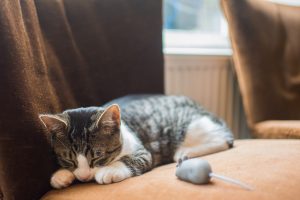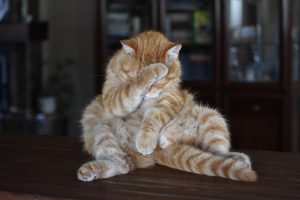When in pain or discomfort, cats will often disguise that they are suffering. As their owner, this can make it difficult for you to understand what’s wrong, as unlike humans, they aren’t able to tell you how they are feeling.
There can be several reasons why your cat is in pain. Significant discomfort can be caused by many factors including problems with their teeth, arthritis, abdominal pain, injury, or your cat may have caught an infection. Cats can show visible signs of why they are in pain, where as some cats may not display any obvious symptoms at all.
Signs your cat is in pain
As a pet owner, you know your cat’s usual behaviour the most, which helps put you in a good position to identify whether your cat is in pain. For example, a change in your cat’s behaviour is a key indicator that they are experiencing discomfort.
To help you understand the warning signals displayed if your cat is in pain, read our advice on what symptoms to be aware of.
-
Your cat’s vocalising.
If your cat is more vocal than usual or growls when you come near them, they could be trying to tell you that they’re in pain.
-
Your cat seeks a safe, quiet place.
If your cat is usually quite sociable and you notice they are withdrawing themselves, this could indicate that they’re in discomfort.
-
Your cat has a change in activity.
If your cat is usually quite active, a reduction in their movement should always be investigated by a vet. There are several causes for this, however a drop in activity can be a warning sign that your cat may be in pain. You may also notice that your cat no longer jumps up, or they are lying down more than usual.
-
Your cat has become disinterested.
You may notice that your cat is no longer interested in playing with their toys, or they are disinterested in their common environment and no longer enjoys lying in their favourite spot.
-
Your cat is guarding or is not using a part of their body.
If you notice that your cat has begun to protect an area of their body such as being hunched up to protect their paw, or they are refraining from putting weight onto a limb, this can be a sign they are in chronic pain.
-
Your cat doesn’t want to be picked up.
Your cat may dislike being picked up which can be a sign of pain or discomfort, especially if they usually like to be held.
-
Your cat stops grooming.
If you notice your cat isn’t grooming themselves as much this can be an indication of pain or an injury. It takes a lot of effort and flexibility for your cat to reach around to groom themselves and if they are in pain this can be aggravated as they turn or twist.
-
Your cat looks different.
Cats in pain will often change their facial expressions; their ears can droop down and their muzzle can look wider and scrunched up to indicate they are unhappy and distressed.
-
Your cat’s eating habits change.
If a cat is distressed, their appetite can change. If your cat doesn’t seem interested in eating solid food and would rather lick the jelly, this can be a sign that their teeth are causing them pain. You may also find your cat is no longer eating at all.
It would be rare for your cat to show all of these signs at once, and you may just notice one or two of these symptoms. If you suspect your cat is experiencing even the most subtle signs of being in pain, it is best to book an appointment with a vet to have them examined by an expert as soon as possible.
How can I manage my cat’s pain?
Recognising whether your cat is experiencing any of these pain signals is the first step to helping them get on the road to being fit and healthy again. There are a range of medications which can help reduce these symptoms and many treatments don’t involve prescribing tablets.
If you are concerned about your pet being in severe discomfort, requiring emergency treatment, or have noticed a series of changes over a period of time and are worried that your cat may be in pain, contact your local Animal Trust surgery.
One of our friendly and experienced vets will happily examine them; our consultations are always free with you only paying for any medication or treatment your pet requires. Not only will this give you peace of mind, but it will help ensure your cat can live a full and pain-free life.




